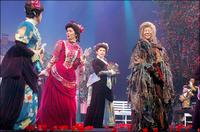PLAYGOER REVIEW: MISHIMA "MODERN NOH PLAYS"


above left, "Sotoba Komachi"; right, "Yoroboshi" (click on either for enlargement)
Just quick impressions of Yukio Ninagawa's visiting production of two Mishima "Modern Noh Plays", perhaps the quietest stunner of the Lincoln Center Festival. (I say "quiet" because it ran only three nights and was reviewed only in Saturday's Times, albeit a rave.) But how rare an opportunity! First, because when was the last time you saw or read anything by Mishima lately? (I fondly remember Bergman's production of Madame de Sade a few years back--a Japanese play starring Swedes playing French aristos.) Second, because this was an evening, finally, as visually exciting as it was thought-provoking.
Ninagawa's pairing of these two particular "Noh" plays, both starring angry young men of postwar Japan, seems to reflect a concern with Mishima's own biography, appropriate for an artist who made his life into his most famous and weirdest work of art. A generation after his controversial death (he committed public sepiku as part of a failed military coup in 1970) he is treated here by Ninagawa as already a "classic" author fit for "reinterpretation."
In each of the plays, Mishima takes inspiration (and the title) from an actual Noh work from the form's golden age, the 14th-17th centuries. And so part of what made the evening so fascinating was experiencing the three-tiered storytelling going on: the original Noh play, Mishima's "adaptation,"and then Ninagawa's re-interpretation of Mishima. The first work, Sotoba Komachi (c.1955), was originally a dialogue at a Buddhist shrine between a priest and Komachi, a 99-yr old woman over her mistreatment of a suitor long ago. Mishima reset the action in a 1950s urban park, replete with young lovers making out on the benches as a foil to the hag, and made her interlocutor a budding poet. As in almost all Noh plays, ghosts appear--but here they are ridiculously Westernized Japanese society folk from the 1880s, Komachi's youth. And just as the traditional Noh climaxes in a dance, here it is a ball of Strauss waltzes. (Mishima's love/hate relationship with the West is a major tension in his work. These "Noh" plays themselves are a deliberately uneasy mixing of native and European dramaturgies.) Ninagawa's bold strokes included Kaoru Kanamori's spooky, night-lit, forrest of a set (far from a walk in the park) on which red flowers constantly rained down, with ungraceful little thuds--a breathtaking and unsettling image of beauty's decay.
The follow-up play was Yoroboshi (1960). The original title character in the Noh classic is a blind boy, expelled from his home, who wins forgiveness of his father after a rain of blessings, in the form of plum blossoms, fall upon him. Mishima's "update" is less comforting. In a cold stately courtroom in postwar Tokyo (another jaw-dropping Kanamori design) it is the parents who must beg Yoroboshi's forgiveness, for abandoning him. His adoptive family is there, too, all Westernized and slickly dressed. Yoroboshi, now a twenty-year-old with attitude, decries both sides, in this bitter custody battle where the family is clearly implied to be the dysfunctional family of 1960 Japan itself. The wounds of past servitude, current capitulation, and the scars of war are all there. Yoroboshi's blindness, as he reveals in a searing climactic monologue, struck him fifteen years earlier, at the age of five, as he witnessed, in an air-raid, "the end of the world." (Whether it is Hiroshima or the "fire bombing" of Tokyo that is being referenced becomes beside the point--the impact of each is felt.)
It is at the end of this piece that Ninagawa attempts his boldest interpolation--closing with the audio from Mishima's real-life suicide speech. Bringing this sublime evening to a close with a dose of "snuff" might have crossed the line for many people. But the connection he was making between writer and protagonist was clear to me. ("Everyone loves me" is the eerie last line--indeed Mishima was the darling of the West--until he turned on them with ugly militarism.) No doubt about it, Mishima was a messed up writer and apparently a horrible person. But his struggle with his own violent and self-aggrandizing impulses (and between his super-macho Samurai posing and his culturally transgressive homosexuality) make for fascinating art, along the lines of the kind of darkly post-Romantic poets such as Baudelaire and Verlaine (or even, in a more personal similarity, Pound) who Mishima emulated.
Let me be clear: this success of this production was not in making Mishima any more "accessible" or "palatable" to a Western audience. (The implied condemnation of us by Yoroboshi, for instance, was particularly unvarnished.) Instead, a foreign writer became somehow clearer to us by a Japanese director embracing what may be most culturally particular about him. And these are certainly "strange" plays by any cultural standard. Mishima followed not one tradition, but several--in addition to inventing his own.
Other reviews: NYTimes (Brantley); V.Voice (Feingold). Interestingly, no one seems to be able to agree on what music Ninigawa was using in the first act. Brantley asks if it's Faure's "Dolly"; Feingold (whose musical expertise matches his theatrical) insists it was Rachmaninoff's "Vocalise". To Playgoer it was obviously's Ravel's "Pavane for a Dead Princess", if for no other reason than the poetic aptness of the title for the olf Kamachi of Mishima's play. What gives?
UPDATE: None other than Terry Teachout says I'm right about the music!







2 comments:
That's such an excellent review! Thank you!
And here I am, 20 years later, of course never watche the production - and regreting it to the core. Thank you for your review.
Post a Comment